Compton Scattering
Definition 
Compton scattering occurs when a photon interacts with a charged particle, in particular with an electron. In the process the photon loses energy and deviates by putting the electron in motion:

ID:(9176, 0)
Scattering
Image 
Scattering that contributes (in) or describes the abandonment of particles (out) can be plotted as follows:

It should be noted that the term collision:
- integrates on all external speeds to those of volume
- includes the likelihood of both speeds leading to scattering simultaneously
- the relative velocity multiplied by the total effective section represents the flow of particles towards the target
The latter can be shown in a simple way through
ID:(9177, 0)
Simulador random walk with Compton scattering
Note 
The Klein-Nishina model can be studied in numerical form. This is shown
- the total effective section as a function of photon energy
- the differential section as a function of the angle for the minimum, medium and maximum energies defined
- what would be the total effective section in a one-dimensional system that gives according to the energy transmission or reflection
ID:(9114, 0)
Modeling with Scattering (2D)
Description 
Variables
Calculations
Calculations
Equations
Examples
Compton scattering occurs when a photon interacts with an electron by transferring the first energy to the second (inelastic interaction). The wavelength of the photon after the scattering can be calculated by
| $\lambda_2=\lambda+\lambda_c(1-\cos\theta)$ |
where
| $\lambda_c=\displaystyle\frac{h}{m_ec}$ |
Compton wave length and
(ID 9145)
Compton scattering occurs when a photon interacts with a charged particle, in particular with an electron. In the process the photon loses energy and deviates by putting the electron in motion:

(ID 9176)
In the case of Compton scattering, the differential effective section is according to Klein-Nishina
| $\displaystyle\frac{d\sigma_{KN}}{d\Omega}=\displaystyle\frac{3}{16\pi}\displaystyle\frac{\sigma_T}{(1+\epsilon(1-\cos\theta))^2}\left(\epsilon(1-cos\theta)+\displaystyle\frac{1}{1+\epsilon(1-\cos\theta)}-\cos^2\theta\right)$ |
where
| $\sigma_T=\displaystyle\frac{8\pi}{3}r_0^2$ |
is the Thomson total effective section and the
| $\epsilon=\displaystyle\frac{E}{m_ec^2}$ |
is the normalized energy.
(ID 9144)
The Compton wavelength is defined by
| $\lambda_c=\displaystyle\frac{h}{m_ec}$ |
where
(ID 9146)
Scattering that contributes (in) or describes the abandonment of particles (out) can be plotted as follows:

It should be noted that the term collision:
- integrates on all external speeds to those of volume
- includes the likelihood of both speeds leading to scattering simultaneously
- the relative velocity multiplied by the total effective section represents the flow of particles towards the target
The latter can be shown in a simple way through
(ID 9177)
The solid angle is defined by
| $d\Omega=2\pi \sin\theta d\theta$ |
(ID 9147)
If the differential effective section is taken according to Klein-Nishina
| $\displaystyle\frac{d\sigma_{KN}}{d\Omega}=\displaystyle\frac{3}{16\pi}\displaystyle\frac{\sigma_T}{(1+\epsilon(1-\cos\theta))^2}\left(\epsilon(1-cos\theta)+\displaystyle\frac{1}{1+\epsilon(1-\cos\theta)}-\cos^2\theta\right)$ |
and integrates in the solid angle
| $d\Omega=2\pi \sin\theta d\theta$ |
the total effective section is obtained
| $\sigma_{KN}=\displaystyle\frac{3}{4}\sigma_T\left(\displaystyle\frac{(1+\epsilon)}{\epsilon^3}\left(\displaystyle\frac{2\epsilon(1+\epsilon)}{1+2\epsilon}-\log(1+2\epsilon)\right)+\displaystyle\frac{\log(1+2\epsilon)}{2\epsilon}-\displaystyle\frac{(1+3\epsilon)}{(1+2\epsilon)^2}\right)$ |
where
| $\sigma_T=\displaystyle\frac{8\pi}{3}r_0^2$ |
is the effective section of Thomson and the
| $\epsilon=\displaystyle\frac{E}{m_ec^2}$ |
is the normalized energy.
At the limit of small
and in the limit
(ID 9111)
The total effective section of Thomson is equal to 2/3 of the surface of a sphere of radius
| $\sigma_T=\displaystyle\frac{8\pi}{3}r_0^2$ |
The radius
(ID 9112)
To simplify we introduce the initial energy of the photon
| $\epsilon=\displaystyle\frac{E}{m_ec^2}$ |
where
(ID 9113)
The Klein-Nishina model can be studied in numerical form. This is shown
- the total effective section as a function of photon energy
- the differential section as a function of the angle for the minimum, medium and maximum energies defined
- what would be the total effective section in a one-dimensional system that gives according to the energy transmission or reflection
(ID 9114)
ID:(1155, 0)
